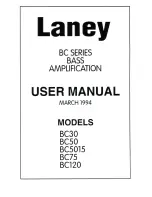
14
Appendices...
2. Preamp Input Impedance
A major element of the sound of a mic pre is related to the interaction between the specific microphone
being used and the type of mic preamp interface technology it is connected to. The main area in which
this interaction has an effect is the level and frequency response of the microphone, as follows:
Level
Professional microphones tend to have low output impedances and so more level can be achieved by
selecting the higher impedance positions of the ISA One mic preamp.
Frequency response
Microphones with defined presence peaks and tailored frequency responses can be further enhanced
by choosing lower impedance settings. Choosing higher input impedance values will tend to
emphasise the high frequency response of the microphone connected, allowing you to get improved
ambient information and high end clarity – even from average-performance microphones. Various
microphone/ISA One preamp impedance combinations can be tried to achieve the desired amount
of colouration for the instrument or voice being recorded. To understand how to use the impedance
selection creatively, it may be useful to read the following section on how the microphone output
impedance and the mic preamp input impedance interact.
Switchable Impedance – In Depth Explanation
Dynamic Moving Coil and Condenser Microphones
Almost all professional dynamic and condenser microphones are designed to have a relatively low
nominal output impedance of between 150 Ω and 300 Ω when measured at 1 kHz. Microphones are
designed to have such low output impedance because the following advantages result:
• They are less susceptible to noise pickup
• They can drive long cables without high frequency roll-off due to cable capacitance
The side-effect of having such low output impedance is that the mic preamp input impedance
has a major effect on the output level of the microphone. Low preamp impedance loads down the
microphone output voltage, and emphasizes any frequency-related variation in microphone output
impedance. Matching the mic preamp resistance to the microphone output impedance (eg., making
a preamp input impedance 200 Ω to match a 200 Ω microphone) still reduces the microphone output
and signal to noise ratio by 6 dB, which is undesirable.
Impedance Setting – Quick Guide
In general the following selections will yield the following results:
High mic preamp impedance settings:
• Will generate more overall level
• Will tend to make low- and mid-frequency response of the microphone flatter
• Will improve high-frequency response of the microphone.
Low preamp impedance settings:
• Will reduce the microphone output level
• Will tend to emphasise the low- and mid-frequency presence peaks and
resonant points of the microphone






































